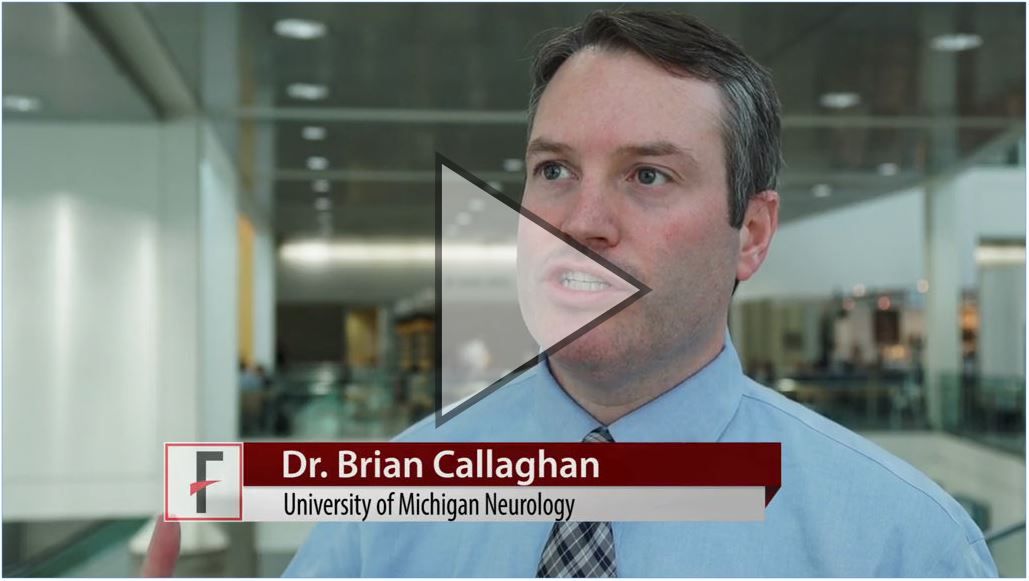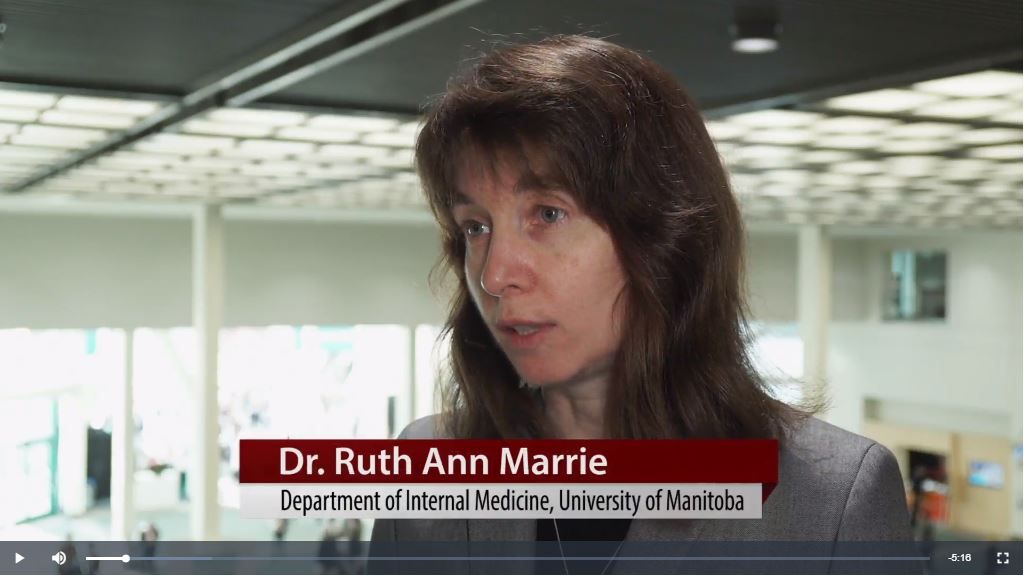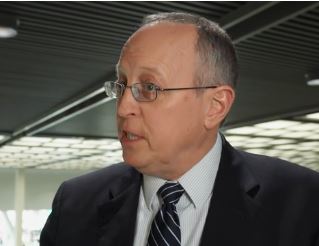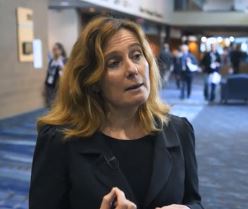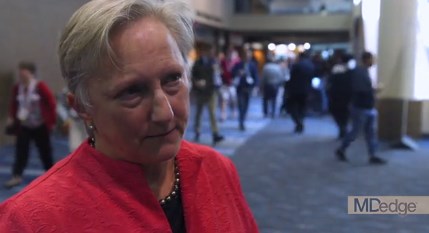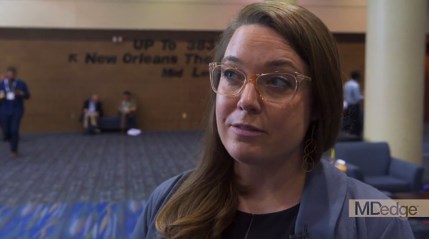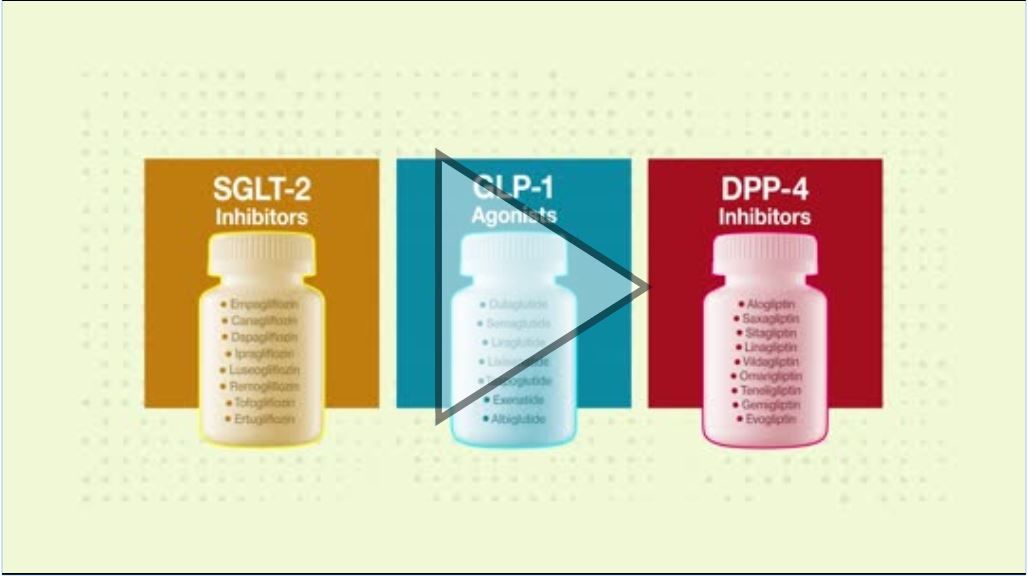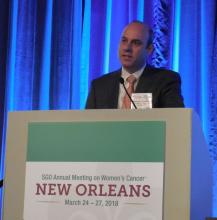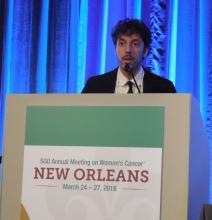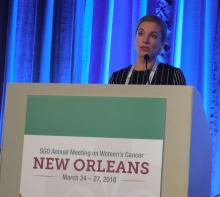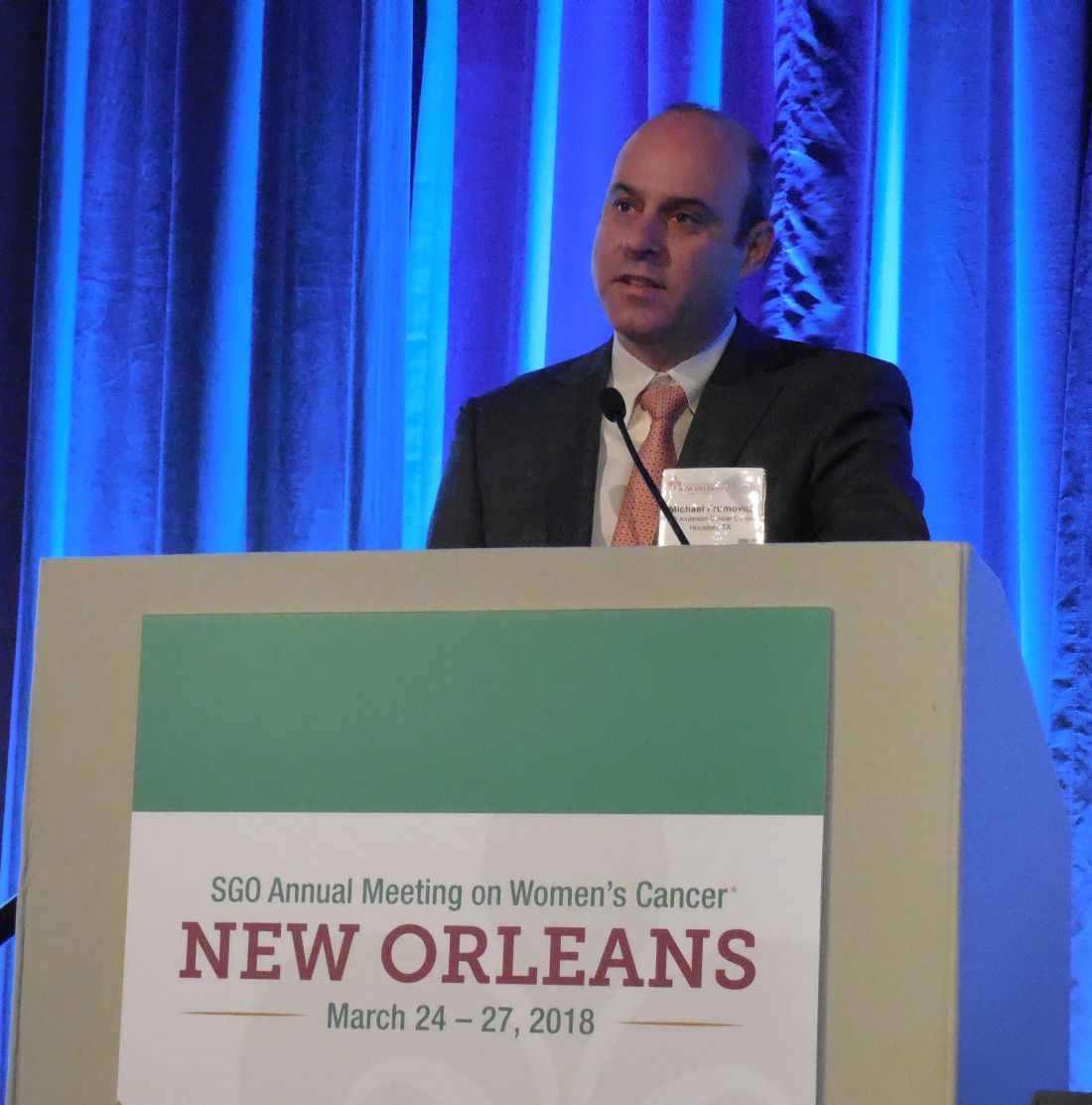User login
VIDEOS: High-priced drugs, out-of-pocket costs raise challenges for neurologists
LOS ANGELES – Neurologists can play an important role in helping patients gain access to high-cost, breakthrough drugs, while at the same time guiding patients to lower-cost options whenever possible, speakers said at the annual meeting of the American Academy of Neurology.
The use of the Orphan Drug approval pathway established in 1983 has gained a great deal of steam for rare neurologic diseases in recent years with the approval of a number of drugs, such as nusinersen (Spinraza) for spinal muscular atrophy, eteplirsen (Exondys 51) for Duchenne muscular dystrophy, and edaravone (Radicava) for amyotrophic lateral sclerosis, said Nicholas Johnson, MD, a pediatric neuromuscular disease specialist at the University of Utah, Salt Lake City.
But given that only 2% of U.S. physicians are neurologists, yet 18% of rare diseases are neurologic and 11% of drugs in development overall are for neurologic diseases, there are a great deal of challenges arising for neurologists in getting access to these new high-priced drugs for their patients, said Dr. Johnson, who leads the AAN’s Neurology Drug Pricing Task Force and is also chair of the AAN Government Relations Committee.
These challenges range from increased administrative burden on staff, getting insurance approval, finding administration sites, and the ability to perform special patient assessments, he said in an interview.
Dr. Nicholas Johnson’s interview:
The video associated with this article is no longer available on this site. Please view all of our videos on the MDedge YouTube channel
Dr. Brian Callaghan’s interview:
The video associated with this article is no longer available on this site. Please view all of our videos on the MDedge YouTube channel
Many high-priced drugs commonly prescribed for chronic neurologic conditions and diagnostic tests also have high out-of-pocket costs for patients, but it is remarkably hard even for well-informed experts to find the actual costs that patients will pay out of pocket for such drugs and tests, according to Brian Callaghan, MD, a neuromuscular disease specialist at the University of Michigan, Ann Arbor.
Neurologist can seek to find more affordable alternatives to drugs when the out-of-pocket expenses are too great, said Dr. Callaghan, who also serves on the Neurology Drug Pricing Task Force. It may be advisable to put certain drugs lower on a list of potential treatment options than others for a chronic condition such as epilepsy because of their out-of-pocket costs, but it can be frustratingly hard to determine these costs in advance.
The University of Michigan Health System is unique in having drug cost data provided as part of information presented to physicians in electronic health records, but this is not the case in most other clinics. Until doctors can regularly access patient-specific drug and diagnostic testing out-of-pocket costs through EHRs, finding the best affordable medications for patients will remain a costly and time-consuming process, he said in an interview.
LOS ANGELES – Neurologists can play an important role in helping patients gain access to high-cost, breakthrough drugs, while at the same time guiding patients to lower-cost options whenever possible, speakers said at the annual meeting of the American Academy of Neurology.
The use of the Orphan Drug approval pathway established in 1983 has gained a great deal of steam for rare neurologic diseases in recent years with the approval of a number of drugs, such as nusinersen (Spinraza) for spinal muscular atrophy, eteplirsen (Exondys 51) for Duchenne muscular dystrophy, and edaravone (Radicava) for amyotrophic lateral sclerosis, said Nicholas Johnson, MD, a pediatric neuromuscular disease specialist at the University of Utah, Salt Lake City.
But given that only 2% of U.S. physicians are neurologists, yet 18% of rare diseases are neurologic and 11% of drugs in development overall are for neurologic diseases, there are a great deal of challenges arising for neurologists in getting access to these new high-priced drugs for their patients, said Dr. Johnson, who leads the AAN’s Neurology Drug Pricing Task Force and is also chair of the AAN Government Relations Committee.
These challenges range from increased administrative burden on staff, getting insurance approval, finding administration sites, and the ability to perform special patient assessments, he said in an interview.
Dr. Nicholas Johnson’s interview:
The video associated with this article is no longer available on this site. Please view all of our videos on the MDedge YouTube channel
Dr. Brian Callaghan’s interview:
The video associated with this article is no longer available on this site. Please view all of our videos on the MDedge YouTube channel
Many high-priced drugs commonly prescribed for chronic neurologic conditions and diagnostic tests also have high out-of-pocket costs for patients, but it is remarkably hard even for well-informed experts to find the actual costs that patients will pay out of pocket for such drugs and tests, according to Brian Callaghan, MD, a neuromuscular disease specialist at the University of Michigan, Ann Arbor.
Neurologist can seek to find more affordable alternatives to drugs when the out-of-pocket expenses are too great, said Dr. Callaghan, who also serves on the Neurology Drug Pricing Task Force. It may be advisable to put certain drugs lower on a list of potential treatment options than others for a chronic condition such as epilepsy because of their out-of-pocket costs, but it can be frustratingly hard to determine these costs in advance.
The University of Michigan Health System is unique in having drug cost data provided as part of information presented to physicians in electronic health records, but this is not the case in most other clinics. Until doctors can regularly access patient-specific drug and diagnostic testing out-of-pocket costs through EHRs, finding the best affordable medications for patients will remain a costly and time-consuming process, he said in an interview.
LOS ANGELES – Neurologists can play an important role in helping patients gain access to high-cost, breakthrough drugs, while at the same time guiding patients to lower-cost options whenever possible, speakers said at the annual meeting of the American Academy of Neurology.
The use of the Orphan Drug approval pathway established in 1983 has gained a great deal of steam for rare neurologic diseases in recent years with the approval of a number of drugs, such as nusinersen (Spinraza) for spinal muscular atrophy, eteplirsen (Exondys 51) for Duchenne muscular dystrophy, and edaravone (Radicava) for amyotrophic lateral sclerosis, said Nicholas Johnson, MD, a pediatric neuromuscular disease specialist at the University of Utah, Salt Lake City.
But given that only 2% of U.S. physicians are neurologists, yet 18% of rare diseases are neurologic and 11% of drugs in development overall are for neurologic diseases, there are a great deal of challenges arising for neurologists in getting access to these new high-priced drugs for their patients, said Dr. Johnson, who leads the AAN’s Neurology Drug Pricing Task Force and is also chair of the AAN Government Relations Committee.
These challenges range from increased administrative burden on staff, getting insurance approval, finding administration sites, and the ability to perform special patient assessments, he said in an interview.
Dr. Nicholas Johnson’s interview:
The video associated with this article is no longer available on this site. Please view all of our videos on the MDedge YouTube channel
Dr. Brian Callaghan’s interview:
The video associated with this article is no longer available on this site. Please view all of our videos on the MDedge YouTube channel
Many high-priced drugs commonly prescribed for chronic neurologic conditions and diagnostic tests also have high out-of-pocket costs for patients, but it is remarkably hard even for well-informed experts to find the actual costs that patients will pay out of pocket for such drugs and tests, according to Brian Callaghan, MD, a neuromuscular disease specialist at the University of Michigan, Ann Arbor.
Neurologist can seek to find more affordable alternatives to drugs when the out-of-pocket expenses are too great, said Dr. Callaghan, who also serves on the Neurology Drug Pricing Task Force. It may be advisable to put certain drugs lower on a list of potential treatment options than others for a chronic condition such as epilepsy because of their out-of-pocket costs, but it can be frustratingly hard to determine these costs in advance.
The University of Michigan Health System is unique in having drug cost data provided as part of information presented to physicians in electronic health records, but this is not the case in most other clinics. Until doctors can regularly access patient-specific drug and diagnostic testing out-of-pocket costs through EHRs, finding the best affordable medications for patients will remain a costly and time-consuming process, he said in an interview.
REPORTING FROM AAN 2018
VIDEO: AAN MS guidelines aim to help clinicians weigh expanding drug choices
LOS ANGELES – A new clinical guideline for adults with multiple sclerosis is designed to help clinicians navigate an increasingly complex landscape of treatment options, its authors say.
The new American Academy of Neurology (AAN) guideline includes some 30 recommendations related to starting a disease-modifying therapy (DMT), switching therapies, or stopping treatment. The guideline, presented April 23 at the AAN annual meeting and published online simultaneously in Neurology, is the first full MS practice guideline issued by AAN since 2002, when only a handful of medications were licensed for use in MS.
The new guideline does not present a hierarchy of DMTs to start but instead weighs evidence for 21 medications or formulations, including 8 used off label, with the idea that clinicians will tailor their choices by considering patient needs, preferences, potential adverse affects, cost of medicines, comorbidities (including depression), and likelihood of adherence, among other factors addressed.
“It’s a dramatically different landscape of the choices clinicians have,” guideline lead author Alexander Rae-Grant, MD, of the Cleveland Clinic, said at a press conference announcing the guideline.
The guideline encourages clinicians and patients “to have a detailed discussion of the risks and benefits of different therapies,” guideline coauthor Ruth Ann Marrie, MD, PhD, of the University of Manitoba, Winnipeg, said at the press conference. “You need to have that informed ... discussion to share decision making – the guideline provides information for each provider-patient dyad to make decisions specific to that patient.”
The guideline incorporates findings from nearly 50 randomized trials, although few of these were head-to-head comparisons of therapies. The authors graded evidence for each DMT as compared with placebo or other DMTs in lowering relapse rate, taking into consideration study design and size. The guideline reflects changes to diagnostic criteria made in 2010, and a classification scheme issued in 2014 for MS subtypes, both of which have complicated the extension of clinical trial findings to some patient groups. It stresses early treatment, recommending that clinicians start DMTs in people with a single clinical demyelinating event and two or more brain lesions characteristic of MS.
Several drugs used off label in MS, including azathioprine and cladribine, were included in the evidence review, with cladribine described as a cost-effective option for patients without the resources to obtain approved agents.
Patients with a new diagnosis of MS should be counseled on starting DMTs not at the time of diagnosis but in a dedicated follow-up visit, the guideline says. Dr. Rae-Grant said that there’s a reasonable amount of “literature to suggest that at the time of diagnosis, what people hear after diagnosis is zero – and that deciding what medication to use is such a weighty decision, we did feel it was important to do that at a different time.”
Dr. Marrie said the AAN guideline “shares some strong similarities” with guidelines released in 2017 by the European Academy of Neurology, including recommendations for early initiation of therapy, for maintaining therapies, and for switching DMTs in individuals not responding or who have breakthrough relapses or changes on MRI.
Dr. Marrie disclosed no conflicts of interest related to her work on the guidelines. Dr. Rae-Grant disclosed income from textbooks on neurology and MS, and no other financial conflicts of interest.
SOURCE: Rae-Grant A et al. Neurology. 2018;90:777-88.
LOS ANGELES – A new clinical guideline for adults with multiple sclerosis is designed to help clinicians navigate an increasingly complex landscape of treatment options, its authors say.
The new American Academy of Neurology (AAN) guideline includes some 30 recommendations related to starting a disease-modifying therapy (DMT), switching therapies, or stopping treatment. The guideline, presented April 23 at the AAN annual meeting and published online simultaneously in Neurology, is the first full MS practice guideline issued by AAN since 2002, when only a handful of medications were licensed for use in MS.
The new guideline does not present a hierarchy of DMTs to start but instead weighs evidence for 21 medications or formulations, including 8 used off label, with the idea that clinicians will tailor their choices by considering patient needs, preferences, potential adverse affects, cost of medicines, comorbidities (including depression), and likelihood of adherence, among other factors addressed.
“It’s a dramatically different landscape of the choices clinicians have,” guideline lead author Alexander Rae-Grant, MD, of the Cleveland Clinic, said at a press conference announcing the guideline.
The guideline encourages clinicians and patients “to have a detailed discussion of the risks and benefits of different therapies,” guideline coauthor Ruth Ann Marrie, MD, PhD, of the University of Manitoba, Winnipeg, said at the press conference. “You need to have that informed ... discussion to share decision making – the guideline provides information for each provider-patient dyad to make decisions specific to that patient.”
The guideline incorporates findings from nearly 50 randomized trials, although few of these were head-to-head comparisons of therapies. The authors graded evidence for each DMT as compared with placebo or other DMTs in lowering relapse rate, taking into consideration study design and size. The guideline reflects changes to diagnostic criteria made in 2010, and a classification scheme issued in 2014 for MS subtypes, both of which have complicated the extension of clinical trial findings to some patient groups. It stresses early treatment, recommending that clinicians start DMTs in people with a single clinical demyelinating event and two or more brain lesions characteristic of MS.
Several drugs used off label in MS, including azathioprine and cladribine, were included in the evidence review, with cladribine described as a cost-effective option for patients without the resources to obtain approved agents.
Patients with a new diagnosis of MS should be counseled on starting DMTs not at the time of diagnosis but in a dedicated follow-up visit, the guideline says. Dr. Rae-Grant said that there’s a reasonable amount of “literature to suggest that at the time of diagnosis, what people hear after diagnosis is zero – and that deciding what medication to use is such a weighty decision, we did feel it was important to do that at a different time.”
Dr. Marrie said the AAN guideline “shares some strong similarities” with guidelines released in 2017 by the European Academy of Neurology, including recommendations for early initiation of therapy, for maintaining therapies, and for switching DMTs in individuals not responding or who have breakthrough relapses or changes on MRI.
Dr. Marrie disclosed no conflicts of interest related to her work on the guidelines. Dr. Rae-Grant disclosed income from textbooks on neurology and MS, and no other financial conflicts of interest.
SOURCE: Rae-Grant A et al. Neurology. 2018;90:777-88.
LOS ANGELES – A new clinical guideline for adults with multiple sclerosis is designed to help clinicians navigate an increasingly complex landscape of treatment options, its authors say.
The new American Academy of Neurology (AAN) guideline includes some 30 recommendations related to starting a disease-modifying therapy (DMT), switching therapies, or stopping treatment. The guideline, presented April 23 at the AAN annual meeting and published online simultaneously in Neurology, is the first full MS practice guideline issued by AAN since 2002, when only a handful of medications were licensed for use in MS.
The new guideline does not present a hierarchy of DMTs to start but instead weighs evidence for 21 medications or formulations, including 8 used off label, with the idea that clinicians will tailor their choices by considering patient needs, preferences, potential adverse affects, cost of medicines, comorbidities (including depression), and likelihood of adherence, among other factors addressed.
“It’s a dramatically different landscape of the choices clinicians have,” guideline lead author Alexander Rae-Grant, MD, of the Cleveland Clinic, said at a press conference announcing the guideline.
The guideline encourages clinicians and patients “to have a detailed discussion of the risks and benefits of different therapies,” guideline coauthor Ruth Ann Marrie, MD, PhD, of the University of Manitoba, Winnipeg, said at the press conference. “You need to have that informed ... discussion to share decision making – the guideline provides information for each provider-patient dyad to make decisions specific to that patient.”
The guideline incorporates findings from nearly 50 randomized trials, although few of these were head-to-head comparisons of therapies. The authors graded evidence for each DMT as compared with placebo or other DMTs in lowering relapse rate, taking into consideration study design and size. The guideline reflects changes to diagnostic criteria made in 2010, and a classification scheme issued in 2014 for MS subtypes, both of which have complicated the extension of clinical trial findings to some patient groups. It stresses early treatment, recommending that clinicians start DMTs in people with a single clinical demyelinating event and two or more brain lesions characteristic of MS.
Several drugs used off label in MS, including azathioprine and cladribine, were included in the evidence review, with cladribine described as a cost-effective option for patients without the resources to obtain approved agents.
Patients with a new diagnosis of MS should be counseled on starting DMTs not at the time of diagnosis but in a dedicated follow-up visit, the guideline says. Dr. Rae-Grant said that there’s a reasonable amount of “literature to suggest that at the time of diagnosis, what people hear after diagnosis is zero – and that deciding what medication to use is such a weighty decision, we did feel it was important to do that at a different time.”
Dr. Marrie said the AAN guideline “shares some strong similarities” with guidelines released in 2017 by the European Academy of Neurology, including recommendations for early initiation of therapy, for maintaining therapies, and for switching DMTs in individuals not responding or who have breakthrough relapses or changes on MRI.
Dr. Marrie disclosed no conflicts of interest related to her work on the guidelines. Dr. Rae-Grant disclosed income from textbooks on neurology and MS, and no other financial conflicts of interest.
SOURCE: Rae-Grant A et al. Neurology. 2018;90:777-88.
REPORTING FROM AAN 2018
VIDEO: Encouraging results reported for novel Huntington’s disease therapy
LOS ANGELES – Results from the first-in-human trial of the investigational antisense oligonucleotide therapy IONIS-HTTRx showed strong dose-dependent reductions in the toxic huntingtin protein in Huntington’s disease patients’ cerebrospinal fluid when compared with placebo.
An exploratory analysis also showed signals of clinical improvement among patients receiving the therapy, the study’s lead author, Sarah Tabrizi, MD, PhD, of University College London, reported at the annual meeting of the American Academy of Neurology.
The findings represent a potential breakthrough in the way Huntington’s – and possibly other neurodegenerative diseases – are treated, said Dr. Tabrizi of University College London. The intrathecally-delivered drug binds to mutant huntingtin protein mRNA to reduce the level of the toxic protein being made.
In the phase 1/2a trial, Dr. Tabrizi and her colleagues enrolled 46 patients with early-stage Huntington’s disease and randomized them to four doses of IONIS-HTTRx or placebo. Patients received four monthly injections of the study drug into the cerebrospinal fluid followed by a 4-month untreated follow-up period. IONIS-HTTRx was delivered in five ascending-dose cohorts.
IONIS-HTTRx was safe and well tolerated and all patients completed the study, Dr. Tabrizi reported. “Our results show that we had significant lowering of the toxic mutant huntingtin protein in the spinal fluid of the patients,” she said, noting that patients receiving the highest doses saw 40%-60% lowering of the protein, which preclinical work suggests correlates to reductions of the protein in the brain.
Dr. Tabrizi stressed that the main outcome measures in the study were reduction of the mutant protein in the CSF and safety and tolerance of the study drug. The investigators did not expect to see clinical measures to change in such a short, small study, she said.
“But then when we looked more carefully at the data with exploratory analysis we found a link between lowering of CSF mutant huntingtin and improvement in total motor score, which is a measure of neurological function, and also, improvement in the Symbol Digit Modalities Test.”
The clinical results are exploratory and require confirmation in larger studies, Dr. Tabrizi stressed.
The study was supported by Ionis Pharmaceuticals. Roche will develop the drug in further clinical trials.
SOURCE: Tabrizi S et al. AAN 2018 abstract CT.002.
LOS ANGELES – Results from the first-in-human trial of the investigational antisense oligonucleotide therapy IONIS-HTTRx showed strong dose-dependent reductions in the toxic huntingtin protein in Huntington’s disease patients’ cerebrospinal fluid when compared with placebo.
An exploratory analysis also showed signals of clinical improvement among patients receiving the therapy, the study’s lead author, Sarah Tabrizi, MD, PhD, of University College London, reported at the annual meeting of the American Academy of Neurology.
The findings represent a potential breakthrough in the way Huntington’s – and possibly other neurodegenerative diseases – are treated, said Dr. Tabrizi of University College London. The intrathecally-delivered drug binds to mutant huntingtin protein mRNA to reduce the level of the toxic protein being made.
In the phase 1/2a trial, Dr. Tabrizi and her colleagues enrolled 46 patients with early-stage Huntington’s disease and randomized them to four doses of IONIS-HTTRx or placebo. Patients received four monthly injections of the study drug into the cerebrospinal fluid followed by a 4-month untreated follow-up period. IONIS-HTTRx was delivered in five ascending-dose cohorts.
IONIS-HTTRx was safe and well tolerated and all patients completed the study, Dr. Tabrizi reported. “Our results show that we had significant lowering of the toxic mutant huntingtin protein in the spinal fluid of the patients,” she said, noting that patients receiving the highest doses saw 40%-60% lowering of the protein, which preclinical work suggests correlates to reductions of the protein in the brain.
Dr. Tabrizi stressed that the main outcome measures in the study were reduction of the mutant protein in the CSF and safety and tolerance of the study drug. The investigators did not expect to see clinical measures to change in such a short, small study, she said.
“But then when we looked more carefully at the data with exploratory analysis we found a link between lowering of CSF mutant huntingtin and improvement in total motor score, which is a measure of neurological function, and also, improvement in the Symbol Digit Modalities Test.”
The clinical results are exploratory and require confirmation in larger studies, Dr. Tabrizi stressed.
The study was supported by Ionis Pharmaceuticals. Roche will develop the drug in further clinical trials.
SOURCE: Tabrizi S et al. AAN 2018 abstract CT.002.
LOS ANGELES – Results from the first-in-human trial of the investigational antisense oligonucleotide therapy IONIS-HTTRx showed strong dose-dependent reductions in the toxic huntingtin protein in Huntington’s disease patients’ cerebrospinal fluid when compared with placebo.
An exploratory analysis also showed signals of clinical improvement among patients receiving the therapy, the study’s lead author, Sarah Tabrizi, MD, PhD, of University College London, reported at the annual meeting of the American Academy of Neurology.
The findings represent a potential breakthrough in the way Huntington’s – and possibly other neurodegenerative diseases – are treated, said Dr. Tabrizi of University College London. The intrathecally-delivered drug binds to mutant huntingtin protein mRNA to reduce the level of the toxic protein being made.
In the phase 1/2a trial, Dr. Tabrizi and her colleagues enrolled 46 patients with early-stage Huntington’s disease and randomized them to four doses of IONIS-HTTRx or placebo. Patients received four monthly injections of the study drug into the cerebrospinal fluid followed by a 4-month untreated follow-up period. IONIS-HTTRx was delivered in five ascending-dose cohorts.
IONIS-HTTRx was safe and well tolerated and all patients completed the study, Dr. Tabrizi reported. “Our results show that we had significant lowering of the toxic mutant huntingtin protein in the spinal fluid of the patients,” she said, noting that patients receiving the highest doses saw 40%-60% lowering of the protein, which preclinical work suggests correlates to reductions of the protein in the brain.
Dr. Tabrizi stressed that the main outcome measures in the study were reduction of the mutant protein in the CSF and safety and tolerance of the study drug. The investigators did not expect to see clinical measures to change in such a short, small study, she said.
“But then when we looked more carefully at the data with exploratory analysis we found a link between lowering of CSF mutant huntingtin and improvement in total motor score, which is a measure of neurological function, and also, improvement in the Symbol Digit Modalities Test.”
The clinical results are exploratory and require confirmation in larger studies, Dr. Tabrizi stressed.
The study was supported by Ionis Pharmaceuticals. Roche will develop the drug in further clinical trials.
SOURCE: Tabrizi S et al. AAN 2018 abstract CT.002.
REPORTING FROM AAN 2018
VIDEO: Ubrogepant reduced pain, related symptoms of a migraine attack
LOS ANGELES – The investigational oral calcitonin gene-related peptide (CGRP) blocker ubrogepant proved superior to placebo in treating a single, acute, moderate to severe migraine attack in the phase 3 ACHIEVE I trial.
Blocking the function of CGRP when it is pathologically released during a migraine attack is the mechanism of a bevy of antagonists under development for treating migraine, and the ACHIEVE I trial results are the first to be reported from a phase 3 trial of an oral small molecule to treat single migraine attacks rather than prevent attacks with monoclonal antibodies targeting CGRP or its receptor, according to the lead author of ACHIEVE I, Joel M. Trugman, MD, director of clinical development for Allergan.
Dr. Trugman and his colleagues recruited 1,672 adult patients (88% female, mean age 41) with a history of migraine with or without aura, and randomized them to placebo, ubrogepant 50 mg, or ubrogepant 100 mg. Patients were instructed to treat a single migraine attack of moderate to severe pain intensity and record symptoms, such as pain, light sensitivity, and sound sensitivity, before and after taking the medication.
“The paradigm for this type of trial is to treat a single, well characterized migraine attack in a large population of patients,” Dr. Trugman said in a press conference at the annual meeting of the American Academy of Neurology.
At 2 hours after dosing, the percentage of ubrogepant-treated patients achieving freedom from pain was significantly greater than the percentage of those treated with placebo (50 mg: 19.2%, P = .0023; 100 mg: 21.2%, P = .0003; placebo: 11.8%).
The percentage of ubrogepant-treated patients achieving absence of their most bothersome symptom was also significantly greater than that of placebo (50 mg: 38.6%, P = .0023; 100 mg: 37.7%, P = .0023; placebo: 27.8%).
Adverse events in the ubrogepant groups were similar to those of placebo, the most reported to be nausea, somnolence, and dry mouth.
Several authors are employees of Allergan, which sponsored the study.
SOURCE: Trugman J et al. AAN 2018 emerging science abstract 008.
LOS ANGELES – The investigational oral calcitonin gene-related peptide (CGRP) blocker ubrogepant proved superior to placebo in treating a single, acute, moderate to severe migraine attack in the phase 3 ACHIEVE I trial.
Blocking the function of CGRP when it is pathologically released during a migraine attack is the mechanism of a bevy of antagonists under development for treating migraine, and the ACHIEVE I trial results are the first to be reported from a phase 3 trial of an oral small molecule to treat single migraine attacks rather than prevent attacks with monoclonal antibodies targeting CGRP or its receptor, according to the lead author of ACHIEVE I, Joel M. Trugman, MD, director of clinical development for Allergan.
Dr. Trugman and his colleagues recruited 1,672 adult patients (88% female, mean age 41) with a history of migraine with or without aura, and randomized them to placebo, ubrogepant 50 mg, or ubrogepant 100 mg. Patients were instructed to treat a single migraine attack of moderate to severe pain intensity and record symptoms, such as pain, light sensitivity, and sound sensitivity, before and after taking the medication.
“The paradigm for this type of trial is to treat a single, well characterized migraine attack in a large population of patients,” Dr. Trugman said in a press conference at the annual meeting of the American Academy of Neurology.
At 2 hours after dosing, the percentage of ubrogepant-treated patients achieving freedom from pain was significantly greater than the percentage of those treated with placebo (50 mg: 19.2%, P = .0023; 100 mg: 21.2%, P = .0003; placebo: 11.8%).
The percentage of ubrogepant-treated patients achieving absence of their most bothersome symptom was also significantly greater than that of placebo (50 mg: 38.6%, P = .0023; 100 mg: 37.7%, P = .0023; placebo: 27.8%).
Adverse events in the ubrogepant groups were similar to those of placebo, the most reported to be nausea, somnolence, and dry mouth.
Several authors are employees of Allergan, which sponsored the study.
SOURCE: Trugman J et al. AAN 2018 emerging science abstract 008.
LOS ANGELES – The investigational oral calcitonin gene-related peptide (CGRP) blocker ubrogepant proved superior to placebo in treating a single, acute, moderate to severe migraine attack in the phase 3 ACHIEVE I trial.
Blocking the function of CGRP when it is pathologically released during a migraine attack is the mechanism of a bevy of antagonists under development for treating migraine, and the ACHIEVE I trial results are the first to be reported from a phase 3 trial of an oral small molecule to treat single migraine attacks rather than prevent attacks with monoclonal antibodies targeting CGRP or its receptor, according to the lead author of ACHIEVE I, Joel M. Trugman, MD, director of clinical development for Allergan.
Dr. Trugman and his colleagues recruited 1,672 adult patients (88% female, mean age 41) with a history of migraine with or without aura, and randomized them to placebo, ubrogepant 50 mg, or ubrogepant 100 mg. Patients were instructed to treat a single migraine attack of moderate to severe pain intensity and record symptoms, such as pain, light sensitivity, and sound sensitivity, before and after taking the medication.
“The paradigm for this type of trial is to treat a single, well characterized migraine attack in a large population of patients,” Dr. Trugman said in a press conference at the annual meeting of the American Academy of Neurology.
At 2 hours after dosing, the percentage of ubrogepant-treated patients achieving freedom from pain was significantly greater than the percentage of those treated with placebo (50 mg: 19.2%, P = .0023; 100 mg: 21.2%, P = .0003; placebo: 11.8%).
The percentage of ubrogepant-treated patients achieving absence of their most bothersome symptom was also significantly greater than that of placebo (50 mg: 38.6%, P = .0023; 100 mg: 37.7%, P = .0023; placebo: 27.8%).
Adverse events in the ubrogepant groups were similar to those of placebo, the most reported to be nausea, somnolence, and dry mouth.
Several authors are employees of Allergan, which sponsored the study.
SOURCE: Trugman J et al. AAN 2018 emerging science abstract 008.
REPORTING FROM AAN 2018
VIDEO: Fix physician burnout? You need more than yoga
NEW ORLEANS – Among a growing number of physicians, the words of a Righteous Brothers’ song ring true about their careers: They’ve lost that loving feeling.
For burned-out physicians, “they’ve lost that sense that they’re making a difference,” explained Susan Thompson Hingle, MD, of Southern Illinois University in Springfield. And the solutions aren’t simple. “You can’t yoga your way out of this,” Dr. Hingle cautioned.
At the annual meeting of the American College of Physicians, Dr. Hingle and Daisy Smith, MD, vice president of clinical programs at the ACP, talked about solutions to burnout, including how more traditional approaches can boost physician well-being, such as team-based care, physician champions, and increasing the pool of primary care providers.
But they also detailed ways that struggling physicians can find support from an unlikely source: their patients.
Dr. Smith’s video interview:
Dr. Hingle’s video interview:
NEW ORLEANS – Among a growing number of physicians, the words of a Righteous Brothers’ song ring true about their careers: They’ve lost that loving feeling.
For burned-out physicians, “they’ve lost that sense that they’re making a difference,” explained Susan Thompson Hingle, MD, of Southern Illinois University in Springfield. And the solutions aren’t simple. “You can’t yoga your way out of this,” Dr. Hingle cautioned.
At the annual meeting of the American College of Physicians, Dr. Hingle and Daisy Smith, MD, vice president of clinical programs at the ACP, talked about solutions to burnout, including how more traditional approaches can boost physician well-being, such as team-based care, physician champions, and increasing the pool of primary care providers.
But they also detailed ways that struggling physicians can find support from an unlikely source: their patients.
Dr. Smith’s video interview:
Dr. Hingle’s video interview:
NEW ORLEANS – Among a growing number of physicians, the words of a Righteous Brothers’ song ring true about their careers: They’ve lost that loving feeling.
For burned-out physicians, “they’ve lost that sense that they’re making a difference,” explained Susan Thompson Hingle, MD, of Southern Illinois University in Springfield. And the solutions aren’t simple. “You can’t yoga your way out of this,” Dr. Hingle cautioned.
At the annual meeting of the American College of Physicians, Dr. Hingle and Daisy Smith, MD, vice president of clinical programs at the ACP, talked about solutions to burnout, including how more traditional approaches can boost physician well-being, such as team-based care, physician champions, and increasing the pool of primary care providers.
But they also detailed ways that struggling physicians can find support from an unlikely source: their patients.
Dr. Smith’s video interview:
Dr. Hingle’s video interview:
REPORTING FROM ACP INTERNAL MEDICINE
VIDEO: A treatment plan for medicine’s gender inequities
NEW ORLEANS – Gender inequities may pervade the medical profession, but a new generation of younger physicians – women and men – can help reshape medicine’s mindsets and workplaces.
At the annual meeting of the American College of Physicians, Sue Bornstein, MD, former chief of staff at Baylor University Medical Center in Dallas, and Darilyn Moyer, MD, CEO of the American College of Physicians, talked about the challenges to closing medicine’s gender-equity gaps, from structural bias to backlash. And they outlined strategies for women to broaden career opportunities and achieve fair payment – from mentoring and sponsoring, to leading change from the top of organizations.
The ACP published a position paper on achieving gender equity in the Annals of Internal Medicine.
Dr. Bornstein’s interview:
Dr. Moyer’s interview:
SOURCE: Ann Intern Med. 2018 Apr 17. doi: 10.7326/M17-3438.
NEW ORLEANS – Gender inequities may pervade the medical profession, but a new generation of younger physicians – women and men – can help reshape medicine’s mindsets and workplaces.
At the annual meeting of the American College of Physicians, Sue Bornstein, MD, former chief of staff at Baylor University Medical Center in Dallas, and Darilyn Moyer, MD, CEO of the American College of Physicians, talked about the challenges to closing medicine’s gender-equity gaps, from structural bias to backlash. And they outlined strategies for women to broaden career opportunities and achieve fair payment – from mentoring and sponsoring, to leading change from the top of organizations.
The ACP published a position paper on achieving gender equity in the Annals of Internal Medicine.
Dr. Bornstein’s interview:
Dr. Moyer’s interview:
SOURCE: Ann Intern Med. 2018 Apr 17. doi: 10.7326/M17-3438.
NEW ORLEANS – Gender inequities may pervade the medical profession, but a new generation of younger physicians – women and men – can help reshape medicine’s mindsets and workplaces.
At the annual meeting of the American College of Physicians, Sue Bornstein, MD, former chief of staff at Baylor University Medical Center in Dallas, and Darilyn Moyer, MD, CEO of the American College of Physicians, talked about the challenges to closing medicine’s gender-equity gaps, from structural bias to backlash. And they outlined strategies for women to broaden career opportunities and achieve fair payment – from mentoring and sponsoring, to leading change from the top of organizations.
The ACP published a position paper on achieving gender equity in the Annals of Internal Medicine.
Dr. Bornstein’s interview:
Dr. Moyer’s interview:
SOURCE: Ann Intern Med. 2018 Apr 17. doi: 10.7326/M17-3438.
REPORTING FROM ACP Internal Medicine
VIDEO: ZIP code, not gene code – Social factors shape patients’ health
NEW ORLEANS – What happens outside the exam room often plays a crucial, and crucially overlooked, role in how well or poorly patients respond to medical therapy.
Social determinants – from the bus ride to a clinic to fitting medication compliance into a three-job work day – are at the center of a new push by the American College of Physicians to improve patient care and awaken physicians to the nonmedical factors that frustrate treatment and fuel outcomes failures.
When it comes to patients’ health, American College of Physicians President Jack Ende, MD, says it’s often ZIP code, not gene code, that can make all the difference.
At the annual meeting of the American College of Physicians, Dr. Ende of the University of Pennsylvania, Philadelphia; Sarah Candler, MD, of Baylor College of Medicine, Houston; and Karen DeSalvo, MD, of the University of Texas, Austin, outlined how physicians can look beyond biology and into patients’ social environments, and they shared resources physicians can use to counter social determinants that harm health.
The ACP published a position paper on social determinants of health in the Annals of Internal Medicine.
Dr. Candler's interview:
Dr. DeSalvo's interview:
Dr. Ende's interview:
SOURCE: Ann Intern Med. 2018 Apr 17;168(8):577-8.
NEW ORLEANS – What happens outside the exam room often plays a crucial, and crucially overlooked, role in how well or poorly patients respond to medical therapy.
Social determinants – from the bus ride to a clinic to fitting medication compliance into a three-job work day – are at the center of a new push by the American College of Physicians to improve patient care and awaken physicians to the nonmedical factors that frustrate treatment and fuel outcomes failures.
When it comes to patients’ health, American College of Physicians President Jack Ende, MD, says it’s often ZIP code, not gene code, that can make all the difference.
At the annual meeting of the American College of Physicians, Dr. Ende of the University of Pennsylvania, Philadelphia; Sarah Candler, MD, of Baylor College of Medicine, Houston; and Karen DeSalvo, MD, of the University of Texas, Austin, outlined how physicians can look beyond biology and into patients’ social environments, and they shared resources physicians can use to counter social determinants that harm health.
The ACP published a position paper on social determinants of health in the Annals of Internal Medicine.
Dr. Candler's interview:
Dr. DeSalvo's interview:
Dr. Ende's interview:
SOURCE: Ann Intern Med. 2018 Apr 17;168(8):577-8.
NEW ORLEANS – What happens outside the exam room often plays a crucial, and crucially overlooked, role in how well or poorly patients respond to medical therapy.
Social determinants – from the bus ride to a clinic to fitting medication compliance into a three-job work day – are at the center of a new push by the American College of Physicians to improve patient care and awaken physicians to the nonmedical factors that frustrate treatment and fuel outcomes failures.
When it comes to patients’ health, American College of Physicians President Jack Ende, MD, says it’s often ZIP code, not gene code, that can make all the difference.
At the annual meeting of the American College of Physicians, Dr. Ende of the University of Pennsylvania, Philadelphia; Sarah Candler, MD, of Baylor College of Medicine, Houston; and Karen DeSalvo, MD, of the University of Texas, Austin, outlined how physicians can look beyond biology and into patients’ social environments, and they shared resources physicians can use to counter social determinants that harm health.
The ACP published a position paper on social determinants of health in the Annals of Internal Medicine.
Dr. Candler's interview:
Dr. DeSalvo's interview:
Dr. Ende's interview:
SOURCE: Ann Intern Med. 2018 Apr 17;168(8):577-8.
REPORTING FROM ACP INTERNAL MEDICINE
VIDEO: Screening ECG patch boosts AF diagnoses ninefold
ORLANDO – An ECG patch worn twice for a total of about 24 days produced a nearly ninefold increase in the number of high-risk people diagnosed with atrial fibrillation, compared with those followed with usual care in a randomized trial with 2,655 people.
During 4 months of follow-up, 1,364 high-risk people assigned to ECG patch screening had a 5.1% rate of new atrial fibrillation (AF) diagnoses, compared with a 0.6% rate among 1,291 controls who wore the patch but were identified with new-onset AF using standard follow-up that did not take the patch data into account. This was a statistically significant difference for the study’s primary endpoint, Steven R. Steinhubl, MD, said at the annual meeting of the American College of Cardiology.
The video associated with this article is no longer available on this site. Please view all of our videos on the MDedge YouTube channel
In addition to proving that the ECG patch can better identify asymptomatic people who have AF than conventional means – usually waiting until a stroke occurs or for symptoms to appear – the noninvasive and relatively low-cost patch also gives researchers a new way to try to address the more fundamental medical question created by this line of investigation: How clinically important are relatively brief, asymptomatic episodes of atrial fibrillation, and are patient outcomes improved by treatments begun in this early phase?
The study results “show we can look beyond implantable devices with a less expensive, noninvasive way” to identify patients with asymptomatic AF and determine its natural history and need for intervention, Dr. Steinhubl said in a video interview.
The mSToP (mHealth Screening to Prevent Strokes) trial ran at Scripps and began by identifying more than 359,000 U.S. residents with Aetna health insurance who met the study’s definition of having high AF risk, either by being at least 75 years old, or at least 55 years old and male or at least 65 years old and female. To qualify as high risk those younger than 75 years also had to have at least one clinical risk factor, which could include a prior cerebrovascular event, heart failure, hypertension plus diabetes, obstructive sleep apnea, or any of six other comorbidities. The researchers also excluded potential participants because of several factors, including a history of atrial fibrillation or flutter, current treatment with an anticoagulant, end-stage renal disease, and patients with an implanted pacemaker or defibrillator.
They invited more than 100,000 of these qualifying Aetna beneficiaries to participate, and 2,655 agreed and received by mail a pair of ECG measurement patches (Zio) with instructions to wear one for 2 weeks at the start of the study and to wear the second during the final 2 weeks of the 4-month study period. The participants averaged 73 years of age, and their average CHA2DS2-VASc score was 3.
All patients in the study were told to wear their patches and mail them in, but the researchers used the collected ECG data for diagnosing AF in only the 1,364 patients randomized to the active arm. The ECG findings for the 1,291 controls wasn’t provided to their physicians, and so any new-onset AF had to be found either by symptom onset or incidentally. About one-third of the people assigned to each of the study arms never wore their patches. Those who wore their patches did so for an average of nearly 12 days each. Diagnosis of new-onset AF was based on finding either at least one AF episode recorded by the patches that lasted at least 30 seconds or an AF diagnosis appearing in the patient’s record. The average AF burden – the percentage of time a person with incident AF had an abnormal sinus rhythm – was 0.9%.
Even though many patients did not use their patches, the investigators assessed the primary endpoint of new AF diagnoses during the 4-month study period on an intention-to-treat basis. Their analysis showed an 8.8-fold higher rate of new AF diagnoses among people in the intervention arm whose patch data were used for immediate diagnosis, reported Dr. Steinhubl, an interventional cardiologist and director of digital medicine at the Scripps Translational Science Institute in La Jolla, Ca.
As a secondary endpoint, the researchers merged the entire group of 1,738 participants who had sent in patches with ECG data and compared their 1-year incidence of diagnosed AF against 3,476 matched controls from the Aetna database. After 1 year, the rate of new AF diagnoses was 6.3% in those with patch information and 2.3% among the controls, a threefold difference in diagnosis rates after adjustment for potential confounders.
“The clinical significance of the short AF episodes” manifested by many patch users identified with AF “requires greater clarity, especially in terms of stroke risk,” Dr. Steinhubl said. But he added, “I like to think that, as we learn more, we can look at more than just anticoagulation” as intervention options. For example, if a morbidly obese patient has asymptomatic AF found by patch screening, it might strengthen the case for bariatric surgery if it’s eventually shown that weight loss after bariatric surgery slows AF progression. The same holds true for more aggressive sleep apnea intervention in patients with sleep apnea and asymptomatic AF, as well as for patients with asymptomatic AF and another type of associated comorbidity.
SOURCE: Steinhubl S. ACC 18, Abstract 402-19.
Results from several studies have now shown that some kind of monitoring for AF in asymptomatic, at-risk people results in an increased diagnosis of subclinical AF. Study results also suggest that, in general, people diagnosed with subclinical AF are at a lower risk of stroke than patients with symptomatic AF. As of now, no prospective study has evaluated the efficacy of anticoagulant therapy in people diagnosed with subclinical AF, although such studies are now in progress. Until we have these results, the question of how to manage patients with subclinical AF remains unanswered.
N.A. Mark Estes, MD , is professor of medicine and director of the New England Cardiac Arrhythmia Center at Tufts Medical Center in Boston. He has been a consultant to Boston Scientific, Medtronic, and St. Jude. He made these comments as designated discussant for the mSToPS report.
Results from several studies have now shown that some kind of monitoring for AF in asymptomatic, at-risk people results in an increased diagnosis of subclinical AF. Study results also suggest that, in general, people diagnosed with subclinical AF are at a lower risk of stroke than patients with symptomatic AF. As of now, no prospective study has evaluated the efficacy of anticoagulant therapy in people diagnosed with subclinical AF, although such studies are now in progress. Until we have these results, the question of how to manage patients with subclinical AF remains unanswered.
N.A. Mark Estes, MD , is professor of medicine and director of the New England Cardiac Arrhythmia Center at Tufts Medical Center in Boston. He has been a consultant to Boston Scientific, Medtronic, and St. Jude. He made these comments as designated discussant for the mSToPS report.
Results from several studies have now shown that some kind of monitoring for AF in asymptomatic, at-risk people results in an increased diagnosis of subclinical AF. Study results also suggest that, in general, people diagnosed with subclinical AF are at a lower risk of stroke than patients with symptomatic AF. As of now, no prospective study has evaluated the efficacy of anticoagulant therapy in people diagnosed with subclinical AF, although such studies are now in progress. Until we have these results, the question of how to manage patients with subclinical AF remains unanswered.
N.A. Mark Estes, MD , is professor of medicine and director of the New England Cardiac Arrhythmia Center at Tufts Medical Center in Boston. He has been a consultant to Boston Scientific, Medtronic, and St. Jude. He made these comments as designated discussant for the mSToPS report.
ORLANDO – An ECG patch worn twice for a total of about 24 days produced a nearly ninefold increase in the number of high-risk people diagnosed with atrial fibrillation, compared with those followed with usual care in a randomized trial with 2,655 people.
During 4 months of follow-up, 1,364 high-risk people assigned to ECG patch screening had a 5.1% rate of new atrial fibrillation (AF) diagnoses, compared with a 0.6% rate among 1,291 controls who wore the patch but were identified with new-onset AF using standard follow-up that did not take the patch data into account. This was a statistically significant difference for the study’s primary endpoint, Steven R. Steinhubl, MD, said at the annual meeting of the American College of Cardiology.
The video associated with this article is no longer available on this site. Please view all of our videos on the MDedge YouTube channel
In addition to proving that the ECG patch can better identify asymptomatic people who have AF than conventional means – usually waiting until a stroke occurs or for symptoms to appear – the noninvasive and relatively low-cost patch also gives researchers a new way to try to address the more fundamental medical question created by this line of investigation: How clinically important are relatively brief, asymptomatic episodes of atrial fibrillation, and are patient outcomes improved by treatments begun in this early phase?
The study results “show we can look beyond implantable devices with a less expensive, noninvasive way” to identify patients with asymptomatic AF and determine its natural history and need for intervention, Dr. Steinhubl said in a video interview.
The mSToP (mHealth Screening to Prevent Strokes) trial ran at Scripps and began by identifying more than 359,000 U.S. residents with Aetna health insurance who met the study’s definition of having high AF risk, either by being at least 75 years old, or at least 55 years old and male or at least 65 years old and female. To qualify as high risk those younger than 75 years also had to have at least one clinical risk factor, which could include a prior cerebrovascular event, heart failure, hypertension plus diabetes, obstructive sleep apnea, or any of six other comorbidities. The researchers also excluded potential participants because of several factors, including a history of atrial fibrillation or flutter, current treatment with an anticoagulant, end-stage renal disease, and patients with an implanted pacemaker or defibrillator.
They invited more than 100,000 of these qualifying Aetna beneficiaries to participate, and 2,655 agreed and received by mail a pair of ECG measurement patches (Zio) with instructions to wear one for 2 weeks at the start of the study and to wear the second during the final 2 weeks of the 4-month study period. The participants averaged 73 years of age, and their average CHA2DS2-VASc score was 3.
All patients in the study were told to wear their patches and mail them in, but the researchers used the collected ECG data for diagnosing AF in only the 1,364 patients randomized to the active arm. The ECG findings for the 1,291 controls wasn’t provided to their physicians, and so any new-onset AF had to be found either by symptom onset or incidentally. About one-third of the people assigned to each of the study arms never wore their patches. Those who wore their patches did so for an average of nearly 12 days each. Diagnosis of new-onset AF was based on finding either at least one AF episode recorded by the patches that lasted at least 30 seconds or an AF diagnosis appearing in the patient’s record. The average AF burden – the percentage of time a person with incident AF had an abnormal sinus rhythm – was 0.9%.
Even though many patients did not use their patches, the investigators assessed the primary endpoint of new AF diagnoses during the 4-month study period on an intention-to-treat basis. Their analysis showed an 8.8-fold higher rate of new AF diagnoses among people in the intervention arm whose patch data were used for immediate diagnosis, reported Dr. Steinhubl, an interventional cardiologist and director of digital medicine at the Scripps Translational Science Institute in La Jolla, Ca.
As a secondary endpoint, the researchers merged the entire group of 1,738 participants who had sent in patches with ECG data and compared their 1-year incidence of diagnosed AF against 3,476 matched controls from the Aetna database. After 1 year, the rate of new AF diagnoses was 6.3% in those with patch information and 2.3% among the controls, a threefold difference in diagnosis rates after adjustment for potential confounders.
“The clinical significance of the short AF episodes” manifested by many patch users identified with AF “requires greater clarity, especially in terms of stroke risk,” Dr. Steinhubl said. But he added, “I like to think that, as we learn more, we can look at more than just anticoagulation” as intervention options. For example, if a morbidly obese patient has asymptomatic AF found by patch screening, it might strengthen the case for bariatric surgery if it’s eventually shown that weight loss after bariatric surgery slows AF progression. The same holds true for more aggressive sleep apnea intervention in patients with sleep apnea and asymptomatic AF, as well as for patients with asymptomatic AF and another type of associated comorbidity.
SOURCE: Steinhubl S. ACC 18, Abstract 402-19.
ORLANDO – An ECG patch worn twice for a total of about 24 days produced a nearly ninefold increase in the number of high-risk people diagnosed with atrial fibrillation, compared with those followed with usual care in a randomized trial with 2,655 people.
During 4 months of follow-up, 1,364 high-risk people assigned to ECG patch screening had a 5.1% rate of new atrial fibrillation (AF) diagnoses, compared with a 0.6% rate among 1,291 controls who wore the patch but were identified with new-onset AF using standard follow-up that did not take the patch data into account. This was a statistically significant difference for the study’s primary endpoint, Steven R. Steinhubl, MD, said at the annual meeting of the American College of Cardiology.
The video associated with this article is no longer available on this site. Please view all of our videos on the MDedge YouTube channel
In addition to proving that the ECG patch can better identify asymptomatic people who have AF than conventional means – usually waiting until a stroke occurs or for symptoms to appear – the noninvasive and relatively low-cost patch also gives researchers a new way to try to address the more fundamental medical question created by this line of investigation: How clinically important are relatively brief, asymptomatic episodes of atrial fibrillation, and are patient outcomes improved by treatments begun in this early phase?
The study results “show we can look beyond implantable devices with a less expensive, noninvasive way” to identify patients with asymptomatic AF and determine its natural history and need for intervention, Dr. Steinhubl said in a video interview.
The mSToP (mHealth Screening to Prevent Strokes) trial ran at Scripps and began by identifying more than 359,000 U.S. residents with Aetna health insurance who met the study’s definition of having high AF risk, either by being at least 75 years old, or at least 55 years old and male or at least 65 years old and female. To qualify as high risk those younger than 75 years also had to have at least one clinical risk factor, which could include a prior cerebrovascular event, heart failure, hypertension plus diabetes, obstructive sleep apnea, or any of six other comorbidities. The researchers also excluded potential participants because of several factors, including a history of atrial fibrillation or flutter, current treatment with an anticoagulant, end-stage renal disease, and patients with an implanted pacemaker or defibrillator.
They invited more than 100,000 of these qualifying Aetna beneficiaries to participate, and 2,655 agreed and received by mail a pair of ECG measurement patches (Zio) with instructions to wear one for 2 weeks at the start of the study and to wear the second during the final 2 weeks of the 4-month study period. The participants averaged 73 years of age, and their average CHA2DS2-VASc score was 3.
All patients in the study were told to wear their patches and mail them in, but the researchers used the collected ECG data for diagnosing AF in only the 1,364 patients randomized to the active arm. The ECG findings for the 1,291 controls wasn’t provided to their physicians, and so any new-onset AF had to be found either by symptom onset or incidentally. About one-third of the people assigned to each of the study arms never wore their patches. Those who wore their patches did so for an average of nearly 12 days each. Diagnosis of new-onset AF was based on finding either at least one AF episode recorded by the patches that lasted at least 30 seconds or an AF diagnosis appearing in the patient’s record. The average AF burden – the percentage of time a person with incident AF had an abnormal sinus rhythm – was 0.9%.
Even though many patients did not use their patches, the investigators assessed the primary endpoint of new AF diagnoses during the 4-month study period on an intention-to-treat basis. Their analysis showed an 8.8-fold higher rate of new AF diagnoses among people in the intervention arm whose patch data were used for immediate diagnosis, reported Dr. Steinhubl, an interventional cardiologist and director of digital medicine at the Scripps Translational Science Institute in La Jolla, Ca.
As a secondary endpoint, the researchers merged the entire group of 1,738 participants who had sent in patches with ECG data and compared their 1-year incidence of diagnosed AF against 3,476 matched controls from the Aetna database. After 1 year, the rate of new AF diagnoses was 6.3% in those with patch information and 2.3% among the controls, a threefold difference in diagnosis rates after adjustment for potential confounders.
“The clinical significance of the short AF episodes” manifested by many patch users identified with AF “requires greater clarity, especially in terms of stroke risk,” Dr. Steinhubl said. But he added, “I like to think that, as we learn more, we can look at more than just anticoagulation” as intervention options. For example, if a morbidly obese patient has asymptomatic AF found by patch screening, it might strengthen the case for bariatric surgery if it’s eventually shown that weight loss after bariatric surgery slows AF progression. The same holds true for more aggressive sleep apnea intervention in patients with sleep apnea and asymptomatic AF, as well as for patients with asymptomatic AF and another type of associated comorbidity.
SOURCE: Steinhubl S. ACC 18, Abstract 402-19.
REPORTING FROM ACC 18
Key clinical point: .
Major finding: After 4 months, new AF diagnoses occurred in 5.1% of patch users and 0.6% of usual-care controls.
Study details: mSToPS, a single-center, randomized study with 2,655 people at high risk for developing AF.
Disclosures: mSToPS received support from Aetna, Janssen, and iRhythm. Dr. Steinhubl has been an advisor to Airstrip, DynoSense, EasyG, FocusMotion, LifeWatch, MyoKardia, Novartis, and Spry Health, he serves on the board of Celes Health, and he has received research support from Janssen and Novartis.
Source: Steinhubl S. ACC 18, Abstract 402-19.
VIDEO: Meta-analysis: Mortality, safety data may favor SGLT2 inhibitors in T2DM
Sodium-glucose cotransporter 2 (SGLT2) inhibitors and glucagonlike peptide–1 (GLP-1) agonists were both associated with a lower mortality risk, compared with that seen with dipeptidyl peptidase–4 (DPP-4) inhibitors and in controls, in patients with type 2 diabetes, according to findings from a large network meta-analysis.
In addition, the GLP-1 agonists were associated with a higher risk of adverse events that led to study withdrawal, compared with SGLT2 inhibitors, according to the analysis conducted by Sean L. Zheng, BM BCh, of the department of endocrinology at the Imperial College Healthcare NHS Foundation Trust, London, and his coinvestigators.
“Of the 3 classes tested, SGLT2 inhibition may be preferred over the incretin-based therapies based on their association with lower mortality and their favorable adverse-event profile,” Dr. Zheng and his coinvestigators wrote in a report on the study published in JAMA.
The video associated with this article is no longer available on this site. Please view all of our videos on the MDedge YouTube channel
Source: JAMA
For patients with type 2 diabetes who don’t achieve target glycemic control on metformin, Dr. Zheng and his coauthors noted, international guidelines recommend SGLT2 inhibitors or incretin-based treatments as a next step.
However, there has been little exploration of the relative clinical effectiveness of these drug classes, which has led to uncertainty about what treatment approach is optimal. “When no head-to-head trial exists, network meta-analysis can be used to estimate the effect,” the authors wrote.
To compare the efficacy of the drug classes in reducing mortality and cardiovascular outcomes, Dr. Zheng and his colleagues conducted a systematic review and meta-analysis of 236 randomized clinical trials including 176,310 participants.
The primary outcome of the study was all-cause mortality.
Both SGLT2 inhibitors and GLP-1 agonists were associated with significantly lower all-cause mortality than that seen in controls (placebo or no treatment), while DPP-4 inhibitors were not, investigators found in the meta-analysis.
For that endpoint, SGLT2 inhibitors had an absolute risk difference of –1.0%, with a hazard ratio of 0.80, and GLP-1 agonists had an absolute RD of –0.6% and an HR of 0.88. By contrast, DPP-4 inhibitors had an absolute RD of 0.1% and an HR of 1.02, according to the published report.
Moreover, when compared with DPP-4 inhibitors, SGLT2 inhibitors and GLP-1 agonists were associated with reduced all-cause mortality, with an absolute risk difference of –0.9% and –0.5%, respectively, they found.
SGLT2 inhibitors and GLP-1 agonists also were significantly associated with lower cardiovascular mortality than controls were, while SGLT2 inhibitors were significantly associated with lower heart failure event rates versus those seen controls, they also found.
Safety outcomes analysis showed that GLP-1 agonists, compared with SGLT2 inhibitors and DPP-4 inhibitors, had a higher risk of adverse events that led patients to withdraw from the study.
The DPP-4 inhibitors were associated with increased acute pancreatitis risk, according to the safety analysis. “SGLT2 inhibitors were associated with increased risk of genital infections but not urinary tract infections. There was a high degree of heterogeneity for lower-limb amputations driven by the significant increase in events with canagliflozin but neutral effects of empagliflozin,” they said.
“Careful treatment selection may be necessary to minimize these outcomes in at-risk patients,” Dr. Zheng and his coauthors concluded.
One author reported potential conflicts of interest with Roche Diabetes, Dexcom, Medtronics Diabetes, and others. Another was supported by a grant from the British Heart Foundation. No other conflicts were reported.
SOURCE: Zheng SL et al. JAMA. 2018;319(15):1580-91.
Sodium-glucose cotransporter 2 (SGLT2) inhibitors and glucagonlike peptide–1 (GLP-1) agonists were both associated with a lower mortality risk, compared with that seen with dipeptidyl peptidase–4 (DPP-4) inhibitors and in controls, in patients with type 2 diabetes, according to findings from a large network meta-analysis.
In addition, the GLP-1 agonists were associated with a higher risk of adverse events that led to study withdrawal, compared with SGLT2 inhibitors, according to the analysis conducted by Sean L. Zheng, BM BCh, of the department of endocrinology at the Imperial College Healthcare NHS Foundation Trust, London, and his coinvestigators.
“Of the 3 classes tested, SGLT2 inhibition may be preferred over the incretin-based therapies based on their association with lower mortality and their favorable adverse-event profile,” Dr. Zheng and his coinvestigators wrote in a report on the study published in JAMA.
The video associated with this article is no longer available on this site. Please view all of our videos on the MDedge YouTube channel
Source: JAMA
For patients with type 2 diabetes who don’t achieve target glycemic control on metformin, Dr. Zheng and his coauthors noted, international guidelines recommend SGLT2 inhibitors or incretin-based treatments as a next step.
However, there has been little exploration of the relative clinical effectiveness of these drug classes, which has led to uncertainty about what treatment approach is optimal. “When no head-to-head trial exists, network meta-analysis can be used to estimate the effect,” the authors wrote.
To compare the efficacy of the drug classes in reducing mortality and cardiovascular outcomes, Dr. Zheng and his colleagues conducted a systematic review and meta-analysis of 236 randomized clinical trials including 176,310 participants.
The primary outcome of the study was all-cause mortality.
Both SGLT2 inhibitors and GLP-1 agonists were associated with significantly lower all-cause mortality than that seen in controls (placebo or no treatment), while DPP-4 inhibitors were not, investigators found in the meta-analysis.
For that endpoint, SGLT2 inhibitors had an absolute risk difference of –1.0%, with a hazard ratio of 0.80, and GLP-1 agonists had an absolute RD of –0.6% and an HR of 0.88. By contrast, DPP-4 inhibitors had an absolute RD of 0.1% and an HR of 1.02, according to the published report.
Moreover, when compared with DPP-4 inhibitors, SGLT2 inhibitors and GLP-1 agonists were associated with reduced all-cause mortality, with an absolute risk difference of –0.9% and –0.5%, respectively, they found.
SGLT2 inhibitors and GLP-1 agonists also were significantly associated with lower cardiovascular mortality than controls were, while SGLT2 inhibitors were significantly associated with lower heart failure event rates versus those seen controls, they also found.
Safety outcomes analysis showed that GLP-1 agonists, compared with SGLT2 inhibitors and DPP-4 inhibitors, had a higher risk of adverse events that led patients to withdraw from the study.
The DPP-4 inhibitors were associated with increased acute pancreatitis risk, according to the safety analysis. “SGLT2 inhibitors were associated with increased risk of genital infections but not urinary tract infections. There was a high degree of heterogeneity for lower-limb amputations driven by the significant increase in events with canagliflozin but neutral effects of empagliflozin,” they said.
“Careful treatment selection may be necessary to minimize these outcomes in at-risk patients,” Dr. Zheng and his coauthors concluded.
One author reported potential conflicts of interest with Roche Diabetes, Dexcom, Medtronics Diabetes, and others. Another was supported by a grant from the British Heart Foundation. No other conflicts were reported.
SOURCE: Zheng SL et al. JAMA. 2018;319(15):1580-91.
Sodium-glucose cotransporter 2 (SGLT2) inhibitors and glucagonlike peptide–1 (GLP-1) agonists were both associated with a lower mortality risk, compared with that seen with dipeptidyl peptidase–4 (DPP-4) inhibitors and in controls, in patients with type 2 diabetes, according to findings from a large network meta-analysis.
In addition, the GLP-1 agonists were associated with a higher risk of adverse events that led to study withdrawal, compared with SGLT2 inhibitors, according to the analysis conducted by Sean L. Zheng, BM BCh, of the department of endocrinology at the Imperial College Healthcare NHS Foundation Trust, London, and his coinvestigators.
“Of the 3 classes tested, SGLT2 inhibition may be preferred over the incretin-based therapies based on their association with lower mortality and their favorable adverse-event profile,” Dr. Zheng and his coinvestigators wrote in a report on the study published in JAMA.
The video associated with this article is no longer available on this site. Please view all of our videos on the MDedge YouTube channel
Source: JAMA
For patients with type 2 diabetes who don’t achieve target glycemic control on metformin, Dr. Zheng and his coauthors noted, international guidelines recommend SGLT2 inhibitors or incretin-based treatments as a next step.
However, there has been little exploration of the relative clinical effectiveness of these drug classes, which has led to uncertainty about what treatment approach is optimal. “When no head-to-head trial exists, network meta-analysis can be used to estimate the effect,” the authors wrote.
To compare the efficacy of the drug classes in reducing mortality and cardiovascular outcomes, Dr. Zheng and his colleagues conducted a systematic review and meta-analysis of 236 randomized clinical trials including 176,310 participants.
The primary outcome of the study was all-cause mortality.
Both SGLT2 inhibitors and GLP-1 agonists were associated with significantly lower all-cause mortality than that seen in controls (placebo or no treatment), while DPP-4 inhibitors were not, investigators found in the meta-analysis.
For that endpoint, SGLT2 inhibitors had an absolute risk difference of –1.0%, with a hazard ratio of 0.80, and GLP-1 agonists had an absolute RD of –0.6% and an HR of 0.88. By contrast, DPP-4 inhibitors had an absolute RD of 0.1% and an HR of 1.02, according to the published report.
Moreover, when compared with DPP-4 inhibitors, SGLT2 inhibitors and GLP-1 agonists were associated with reduced all-cause mortality, with an absolute risk difference of –0.9% and –0.5%, respectively, they found.
SGLT2 inhibitors and GLP-1 agonists also were significantly associated with lower cardiovascular mortality than controls were, while SGLT2 inhibitors were significantly associated with lower heart failure event rates versus those seen controls, they also found.
Safety outcomes analysis showed that GLP-1 agonists, compared with SGLT2 inhibitors and DPP-4 inhibitors, had a higher risk of adverse events that led patients to withdraw from the study.
The DPP-4 inhibitors were associated with increased acute pancreatitis risk, according to the safety analysis. “SGLT2 inhibitors were associated with increased risk of genital infections but not urinary tract infections. There was a high degree of heterogeneity for lower-limb amputations driven by the significant increase in events with canagliflozin but neutral effects of empagliflozin,” they said.
“Careful treatment selection may be necessary to minimize these outcomes in at-risk patients,” Dr. Zheng and his coauthors concluded.
One author reported potential conflicts of interest with Roche Diabetes, Dexcom, Medtronics Diabetes, and others. Another was supported by a grant from the British Heart Foundation. No other conflicts were reported.
SOURCE: Zheng SL et al. JAMA. 2018;319(15):1580-91.
FROM JAMA
Key clinical point: that were either placebo or no treatment.
Major finding: When compared with DPP-4 inhibitors, SGLT2 inhibitors and GLP-1 agonists were both associated with reduced all-cause mortality, with an absolute risk difference of –0.9% and –0.5%, respectively.
Study details: A systematic review and meta-analysis of 236 randomized clinical trials including 176,310 participants.
Disclosures: One author reported potential conflicts of interest with Roche Diabetes, Dexcom, Medtronics Diabetes, and others. Another was supported by a grant from the British Heart Foundation. No other conflicts were reported.
Source: Zheng SL et al. JAMA. 2018;319(15):1580-91.
VIDEO: Indocyanine green finds more sentinel lymph nodes
The video associated with this article is no longer available on this site. Please view all of our videos on the MDedge YouTube channel
NEW ORLEANS – Indocyanine green (ICG) worked better than isosulfan blue for mapping sentinel lymph nodes (SLNs) in a pivotal phase 3 trial with 176 patients who had stage I endometrial or cervical cancer.
Four injections of ICG resulted in detection of 96% of the identified SLNs in these patients, including bilateral SLNs in 78% of the patients. In contrast, four injections with isosulfan blue dye led to detection of 74% of all SLNs and identified bilateral SLNs in 31% of the patients, Michael M. Frumovitz, MD, said at the annual meeting of the Society for Gynecologic Oncology.
The FILM trial randomized 176 patients with stage I endometrial or cervical cancer at eight centers in the United States or Canada between December 2015 and May 2017. Patients first received one of the tagging agents and then the second, and then underwent mapping using white light to detect blue-tagged SLNs and near-infrared light to find green-tagged SLNs. The patients were aged 63 years on average, and 96% had endometrial cancer.
The researchers identified 279 sentinel lymph nodes that stained only green, nine SLNs that stained only blue, and 248 SLNs tagged with both dyes. They confirmed tumor cells within all nine of SLNs tagged with blue dye only, in 95% of those tagged with ICG only, and in 92% of the SLNs stained with both dyes. The isosulfan blue dye identified SLNs in two patients who did not have any SLNs detected by the ICG, whereas the ICG identified SLNs in 22 patients who did not have any SLNs detected using the blue dye. Sixteen patients had metastatic disease that had moved to 21 SLNs. The ICG system identified all 21 involved lymph nodes; the blue dye identified 13 of the 21 affected SLNs (62%).
Dr. Frumovitz and his associates designed FILM as primarily a test of noninferiority. The per-protocol analysis with 163 patients showed that ICG was noninferior to isosulfan blue (P less than .001). Once the results demonstrated noninferiority, the study protocol allowed the researchers to test for superiority in the full, intention-to-treat cohort of 176 patients. The results showed that ICG was significantly superior to isosulfan blue (P less than .001). In addition, ICG treatment produced no allergic or other adverse reactions, Dr. Frumovitz said.
Once ICG and the associated near-infrared detection camera receive FDA marketing approval, “I think this will become the standard within 5 years,” he predicted in an interview.
The results also showed that using both ICG and isosulfan blue was not better than using ICG alone. “If you’re using both dyes, you can drop the blue dye. At MD Anderson we’ve used only ICG for about the past year,” Dr. Frumovitz said.
FILM was sponsored by Novadaq/Stryker, the company developing the ICG PINPOINT imaging system. Dr. Frumovitz has been a consultant to Novadaq/Stryker and Genentech and has received research funding from Novadaq/Stryker and Navidea. Dr. Backes has been a consultant to Tesaro and has received research funding from Clovis, Eisai, and ImmunoGen. Dr. Buda had no disclosures.
SOURCE: Frumovitz MM. SGO 2018, Abstract 12. Backes FJ. SGO 2018, Abstract 13.
The results from the FILM trial are potentially practice changing. The findings presented by Michael M. Frumovitz, MD, and his associates showed that indocyanine green is superior to isosulfan blue dye for mapping sentinel lymph nodes in patients with stage I endometrial or cervical cancer. The results also showed that using both dyes was no better than using indocyanine green alone.
The report by Floor J. Backes, MD, addressed an important and still unresolved question in treating patients with stage I or II endometrial cancer: What is the significance of finding isolated tumor cells in sentinel lymph nodes in these patients? The retrospective findings she presented showed that the presence of isolated tumor cells had no apparent effect on recurrence-free survival, recurrence pattern, or patient response to various treatments. This suggested th at treatment decisions in these patients should depend on other high-risk uterine factors but not on whether some lymph nodes contained isolated tumor cells.
Brent Smith, MD , is a gynecologic oncologist at the Ohio State University, Columbus. He had no disclosures. Dr. Smith made these comments in a video interview.
The results from the FILM trial are potentially practice changing. The findings presented by Michael M. Frumovitz, MD, and his associates showed that indocyanine green is superior to isosulfan blue dye for mapping sentinel lymph nodes in patients with stage I endometrial or cervical cancer. The results also showed that using both dyes was no better than using indocyanine green alone.
The report by Floor J. Backes, MD, addressed an important and still unresolved question in treating patients with stage I or II endometrial cancer: What is the significance of finding isolated tumor cells in sentinel lymph nodes in these patients? The retrospective findings she presented showed that the presence of isolated tumor cells had no apparent effect on recurrence-free survival, recurrence pattern, or patient response to various treatments. This suggested th at treatment decisions in these patients should depend on other high-risk uterine factors but not on whether some lymph nodes contained isolated tumor cells.
Brent Smith, MD , is a gynecologic oncologist at the Ohio State University, Columbus. He had no disclosures. Dr. Smith made these comments in a video interview.
The results from the FILM trial are potentially practice changing. The findings presented by Michael M. Frumovitz, MD, and his associates showed that indocyanine green is superior to isosulfan blue dye for mapping sentinel lymph nodes in patients with stage I endometrial or cervical cancer. The results also showed that using both dyes was no better than using indocyanine green alone.
The report by Floor J. Backes, MD, addressed an important and still unresolved question in treating patients with stage I or II endometrial cancer: What is the significance of finding isolated tumor cells in sentinel lymph nodes in these patients? The retrospective findings she presented showed that the presence of isolated tumor cells had no apparent effect on recurrence-free survival, recurrence pattern, or patient response to various treatments. This suggested th at treatment decisions in these patients should depend on other high-risk uterine factors but not on whether some lymph nodes contained isolated tumor cells.
Brent Smith, MD , is a gynecologic oncologist at the Ohio State University, Columbus. He had no disclosures. Dr. Smith made these comments in a video interview.
The video associated with this article is no longer available on this site. Please view all of our videos on the MDedge YouTube channel
NEW ORLEANS – Indocyanine green (ICG) worked better than isosulfan blue for mapping sentinel lymph nodes (SLNs) in a pivotal phase 3 trial with 176 patients who had stage I endometrial or cervical cancer.
Four injections of ICG resulted in detection of 96% of the identified SLNs in these patients, including bilateral SLNs in 78% of the patients. In contrast, four injections with isosulfan blue dye led to detection of 74% of all SLNs and identified bilateral SLNs in 31% of the patients, Michael M. Frumovitz, MD, said at the annual meeting of the Society for Gynecologic Oncology.
The FILM trial randomized 176 patients with stage I endometrial or cervical cancer at eight centers in the United States or Canada between December 2015 and May 2017. Patients first received one of the tagging agents and then the second, and then underwent mapping using white light to detect blue-tagged SLNs and near-infrared light to find green-tagged SLNs. The patients were aged 63 years on average, and 96% had endometrial cancer.
The researchers identified 279 sentinel lymph nodes that stained only green, nine SLNs that stained only blue, and 248 SLNs tagged with both dyes. They confirmed tumor cells within all nine of SLNs tagged with blue dye only, in 95% of those tagged with ICG only, and in 92% of the SLNs stained with both dyes. The isosulfan blue dye identified SLNs in two patients who did not have any SLNs detected by the ICG, whereas the ICG identified SLNs in 22 patients who did not have any SLNs detected using the blue dye. Sixteen patients had metastatic disease that had moved to 21 SLNs. The ICG system identified all 21 involved lymph nodes; the blue dye identified 13 of the 21 affected SLNs (62%).
Dr. Frumovitz and his associates designed FILM as primarily a test of noninferiority. The per-protocol analysis with 163 patients showed that ICG was noninferior to isosulfan blue (P less than .001). Once the results demonstrated noninferiority, the study protocol allowed the researchers to test for superiority in the full, intention-to-treat cohort of 176 patients. The results showed that ICG was significantly superior to isosulfan blue (P less than .001). In addition, ICG treatment produced no allergic or other adverse reactions, Dr. Frumovitz said.
Once ICG and the associated near-infrared detection camera receive FDA marketing approval, “I think this will become the standard within 5 years,” he predicted in an interview.
The results also showed that using both ICG and isosulfan blue was not better than using ICG alone. “If you’re using both dyes, you can drop the blue dye. At MD Anderson we’ve used only ICG for about the past year,” Dr. Frumovitz said.
FILM was sponsored by Novadaq/Stryker, the company developing the ICG PINPOINT imaging system. Dr. Frumovitz has been a consultant to Novadaq/Stryker and Genentech and has received research funding from Novadaq/Stryker and Navidea. Dr. Backes has been a consultant to Tesaro and has received research funding from Clovis, Eisai, and ImmunoGen. Dr. Buda had no disclosures.
SOURCE: Frumovitz MM. SGO 2018, Abstract 12. Backes FJ. SGO 2018, Abstract 13.
The video associated with this article is no longer available on this site. Please view all of our videos on the MDedge YouTube channel
NEW ORLEANS – Indocyanine green (ICG) worked better than isosulfan blue for mapping sentinel lymph nodes (SLNs) in a pivotal phase 3 trial with 176 patients who had stage I endometrial or cervical cancer.
Four injections of ICG resulted in detection of 96% of the identified SLNs in these patients, including bilateral SLNs in 78% of the patients. In contrast, four injections with isosulfan blue dye led to detection of 74% of all SLNs and identified bilateral SLNs in 31% of the patients, Michael M. Frumovitz, MD, said at the annual meeting of the Society for Gynecologic Oncology.
The FILM trial randomized 176 patients with stage I endometrial or cervical cancer at eight centers in the United States or Canada between December 2015 and May 2017. Patients first received one of the tagging agents and then the second, and then underwent mapping using white light to detect blue-tagged SLNs and near-infrared light to find green-tagged SLNs. The patients were aged 63 years on average, and 96% had endometrial cancer.
The researchers identified 279 sentinel lymph nodes that stained only green, nine SLNs that stained only blue, and 248 SLNs tagged with both dyes. They confirmed tumor cells within all nine of SLNs tagged with blue dye only, in 95% of those tagged with ICG only, and in 92% of the SLNs stained with both dyes. The isosulfan blue dye identified SLNs in two patients who did not have any SLNs detected by the ICG, whereas the ICG identified SLNs in 22 patients who did not have any SLNs detected using the blue dye. Sixteen patients had metastatic disease that had moved to 21 SLNs. The ICG system identified all 21 involved lymph nodes; the blue dye identified 13 of the 21 affected SLNs (62%).
Dr. Frumovitz and his associates designed FILM as primarily a test of noninferiority. The per-protocol analysis with 163 patients showed that ICG was noninferior to isosulfan blue (P less than .001). Once the results demonstrated noninferiority, the study protocol allowed the researchers to test for superiority in the full, intention-to-treat cohort of 176 patients. The results showed that ICG was significantly superior to isosulfan blue (P less than .001). In addition, ICG treatment produced no allergic or other adverse reactions, Dr. Frumovitz said.
Once ICG and the associated near-infrared detection camera receive FDA marketing approval, “I think this will become the standard within 5 years,” he predicted in an interview.
The results also showed that using both ICG and isosulfan blue was not better than using ICG alone. “If you’re using both dyes, you can drop the blue dye. At MD Anderson we’ve used only ICG for about the past year,” Dr. Frumovitz said.
FILM was sponsored by Novadaq/Stryker, the company developing the ICG PINPOINT imaging system. Dr. Frumovitz has been a consultant to Novadaq/Stryker and Genentech and has received research funding from Novadaq/Stryker and Navidea. Dr. Backes has been a consultant to Tesaro and has received research funding from Clovis, Eisai, and ImmunoGen. Dr. Buda had no disclosures.
SOURCE: Frumovitz MM. SGO 2018, Abstract 12. Backes FJ. SGO 2018, Abstract 13.
REPORTING FROM SGO 2018
Key clinical point: Indocyanine green surpassed isosulfan blue for sentinel lymph node mapping in a pivotal trial.
Major finding: Researchers mapped sentinel lymph nodes in 96% of patients with indocyanine green and in 74% with isosulfan blue.
Study details: FILM, a multicenter, randomized phase 3 trial with 176 patients.
Disclosures: FILM was sponsored by Novadaq/Stryker, the company developing the ICG PINPOINT imaging system. Dr. Frumovitz has been a consultant to Novadaq/Stryker and Genentech and has received research funding from Novadaq/Stryker and Navidea. Dr. Backes has been a consultant to Tesaro and has received research funding from Clovis, Eisai, and ImmunoGen. Dr. Buda had no disclosures.
Source: Frumovitz MM. SGO 2018, Abstract 12. Backes FJ. SGO 2018, Abstract 13.
